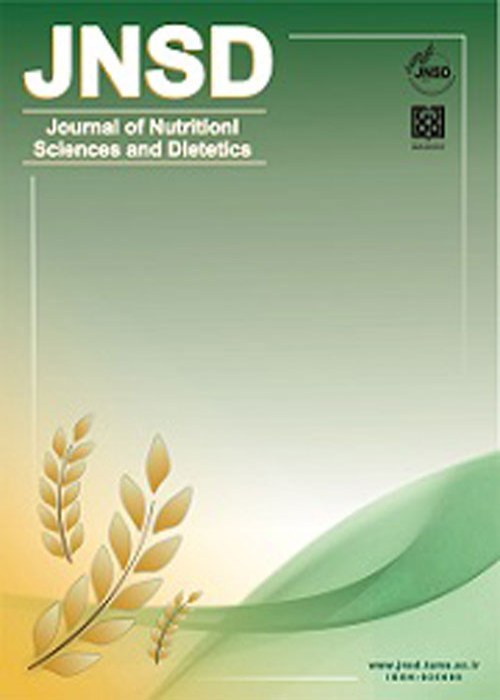In search of safe sources other than oily fish and supplements
Author(s):
Article Type:
Editorial (دارای رتبه معتبر)
Abstract:
Accumulating evidence suggests that higher intakes of omega-3 (n-3) long chain polyunsaturated fatty acids (LC-PUFA), especially eicosapentaenoic acid (EPA) and docosahexaenoic acid (DHA), have various beneficial health in man [1]. Based on research findings in many countries, there has been considerable enthusiasm for using n-3-fatty acids (n-3-FAc) to lower the risk of mental health, inflammatory diseases, immunological disorders and, although somewhat controversial, cardiovascular disease, cancer and mortality [2-3]. It is too be noted that Iran, too, has been involved in this area of clinical research in recent decades, showing the benefits of n-3 FAs in a wide range of cardiovascular risk factors, lipid profile, blood pressure, cardiac function, inflammatory markers, triglycerides, HDL-cholesterol, adipokines, and insulin[4-5], as well as in depression[6] and sport performance[7]. Also, in this issue of JNSD two papers address the beneficial effects of n-3-FA supplementation on heat shock proteins 27 (HSP-27), which can play an important role in the pathogenesis of atherosclerosis (S. Samavat et al.), and on lifestyle modification on depression and anxiety in overweight women (S. Haghravan et al.).Various doses of EPA/DHA have been recommended by international organizations (IOM or AHA), but most n-3-FA experts recommend 500-1000 mg of n-3 EPA/DHA per day for adults to maintain overall good health[8]. Moreover, for patients with documented CHD, the AHA recommends about 1 gram of EPA and DHA (combined) per day. This may be obtained from oily fish or n-3-FA supplements [9]. Widespread advertisement in the media and extensive public health attention to the benefits of n-3-FAs on different aspects of health have led to increased consumption of fish and n-3-FA supplements in populations in many countries. However, the dietary recommendations are not being fully met by most people. Now the vital question is from which sources should sufficient intakes of n-3-FAs be provided?Undoubtedly, dietary approaches are safer and less costly to reduce cardiovascular disease risk and n-3-FA deficiency which is associated with substantial direct and indirect costs. With better reservoir knowledge and advance in scientific technologies, production of n-3s from some unconventional and economically viable sources should be considered. Recently a study has described potential alternative sources of n-3-LC-PUFA including a) algae, which can be used to produce oils rich in both DHA and EPA, although using expensive methodology; b) krill oil, which does not seem to be a major alternative source and is more expensive than fish oil; c) stearidonic acid (SDA)-enriched soybean oil, which is a less expensive than fish; and d) single-cell photosynthetic organisms, which have the potential to convert CO and salt water directly into n-3 fatty acids[10].Despite the beneficial effects of n-3-FAs in reducing risk of some chronic diseases, their intake is very low in many populations, including Iran [5]. Then, we may need to pay attention to other n-3 fatty acid sources than oily fish and to make a strong capacity for the above-mentioned low-cost innovations in Iran.
Language:
English
Published:
Journal of Nutritional Sciences and Dietetics, Volume:1 Issue: 4, Autumn 2015
Pages:
171 to 172
magiran.com/p1909688
دانلود و مطالعه متن این مقاله با یکی از روشهای زیر امکان پذیر است:
اشتراک شخصی
با عضویت و پرداخت آنلاین حق اشتراک یکساله به مبلغ 1,390,000ريال میتوانید 70 عنوان مطلب دانلود کنید!
اشتراک سازمانی
به کتابخانه دانشگاه یا محل کار خود پیشنهاد کنید تا اشتراک سازمانی این پایگاه را برای دسترسی نامحدود همه کاربران به متن مطالب تهیه نمایند!
توجه!
- حق عضویت دریافتی صرف حمایت از نشریات عضو و نگهداری، تکمیل و توسعه مگیران میشود.
- پرداخت حق اشتراک و دانلود مقالات اجازه بازنشر آن در سایر رسانههای چاپی و دیجیتال را به کاربر نمیدهد.
In order to view content subscription is required
Personal subscription
Subscribe magiran.com for 70 € euros via PayPal and download 70 articles during a year.
Organization subscription
Please contact us to subscribe your university or library for unlimited access!


